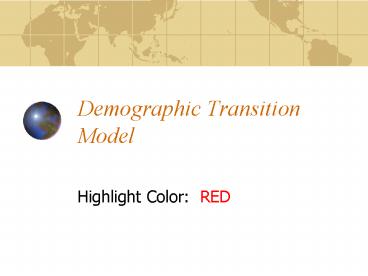Demographic Transition Model PowerPoint PPT Presentation
1 / 12
Title: Demographic Transition Model
1
Demographic Transition Model
- Highlight Color RED
2
The Problem
- The size, composition, and growth of population
affect the economic and environmental well-being
of nations. - Rapid population growth in regions such as
sub-Saharan Africa and the Middle East require
huge commitments of national resources. - Countries with declining growth rates may have
large elderly populations that require large
expenditures of resources to support the aging.
3
The Study
- Geographers and demographers use the Demographic
Transition Model as a framework for
understanding the dramatic variations in birth,
death, and growth rates world wide. - Based on the demographic history of European
countries, the demographic transition model
offers a generalized perspective of the way
birth, death, and growth rates change through
time.
4
The Demographic Transition Model
5
The Demographic Transition
- Stage 1 Low Growth
- Stage 2 High Growth
- Stage 3 Moderate Growth
- Stage 4 Low Growth or Stationary
- Stationary population level (SPL)?
6
STAGE I Low Growth
- A - Stage 1Both high birth rates and death
rates fluctuate in the first stage of the
population model giving a small population growth
(shown by the small total population graph).
There are many reasons for this - little access to birth control
- many children die in infancy (high infant
mortality) so parents tend to have more children
to compensate in the hopes that more will live - children are needed to work on the land to grow
food for the family - children are regarded as a sign of virility in
some cultures - religious beliefs (e.g., Roman Catholics and
Hindus) encourage large families - high death rates, especially among children
because of disease, famine, poor diet, poor
hygiene, little medical science.
7
STAGE 2 High Growth
- B - Stage 2Birth rates remain high, but death
rates fall rapidly causing a high population
growth (as shown by the total population graph).
The reasons for this could be - improvements in medical care - hospitals,
medicines, etc. - improvements in sanitation and water supply
- quality and quantity of food produced rises
- transport and communications improve the
movements of food and medical supplies - decrease in infant mortality.
8
STAGE 3Moderate Growth
- C - Stage 3Birth rates now fall rapidly while
death rates continue to fall. The total
population begins to peak and the population
increase slows to a constant. The reasons for
this could be - increased access to contraception
- lower infant mortality rate means there is less
need to have a bigger family - industrialization and mechanization means fewer
laborers are required - the desire for material possessions takes over
the desire for large families as wealth increases
- equality for women means that they are able to
follow a career path rather than feeling
obligated to have a family.
9
STAGE 4 Low Growth/ Stationary
- D - Stage 4Both birth rates and death rates
remain low, fluctuating with 'baby booms' and
epidemics of illnesses and disease. This results
in a steady population.
10
One last look
- Stage 5?A stage 5 was not originally thought
of as part of the DTM, but some northern
countries are now reaching the stage where total
population is declining and where birth rates
have dropped below death rates. One such country
is Germany, which has taken in foreign workers to
fill jobs. The UK's population is expected to
start declining by 2021.
11
Limitations
- Although the demographic transition model is a
compelling and an extremely useful framework for
viewing contemporary population change, we must
be careful in using it to predict the future of
Third World countries currently in the second or
third stages. - Their economies and populations are so different
from those of Europe that we cannot be sure their
demographic transition will resolve in the same
way.
12
Your Task
- In your notebook recreate the Demographic
transition model. - Using pg. 54 in your textbook and your notes
- Indicate trends in birth rate and death rate
- Label possible reasons for these trends within
each stage. - I will check and give you points first thing
tomorrow.

